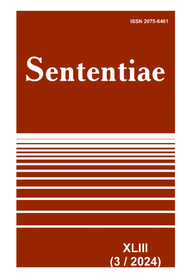Kant's Doctrine of Sensibility, Space and Time: Transcendental, Anthropological and Natural Science Connotations
DOI:
https://doi.org/10.31649/sent43.03.081Keywords:
transcendental aesthetics, anthropological grounds of forms of sensory intuition, intellectual intuition, intuitive reason, transcendental foundations of natural scienceAbstract
The author examines Kant’s transcendental doctrine of space and time in order to find out possible anthropological connotations of the German philosopher’s topology. The analysis allows us to draw the following conclusions: 1) the anthropological features of space and time significantly correct the transcendental understanding of space and time as forms of sensual intuition; 2) the anthropological connotations of the forms of space and time make it impossible to have both noumenal, intellectual intuition of things and intuition based on a different topology, on configurations of the world that are different from those familiar to humans; 3) Kant’s achievement is his work «Metaphysical Foundations of Natural Science» (1786), which demonstrates the effectiveness of the transcendental method, in particular transcendental aesthetics, in substantiating the natural sciences (physics) of the time, which made it possible to prove the close connection of the natural sciences with the transcendental conditions of experience.
References
Aquila, R. (1994). The Holistic Character of Kantian Intuition. In P. Parrini (Ed.), Kant and Con-temporary Epistemology (pp. 309-329). Boston: Kluwer. https://doi.org/10.1007/978-94-011-0834-8_17
Beck, M. (2023). Konstruktion und Entäußerung Bildlogik und anschauliches Denken bei Kant und Hegel. Hamburg: Meiner. https://doi.org/10.28937/978-3-7873-4030-9
Brandt, R. (1998). Transzendentale Ästhetik, §§1-3 (A19/B33-A30/B45). In G. Mohr & M. Willa-schek (Hrsg), Immanuel Kant: Kritik der reinen Vernunft (S. 81-106). Berlin: Akademie Ver-lag. https://doi.org/10.1524/9783050050386.81
Brewer, K. (2022). Kant’s Theory of the Intuitive Intellect. History of Philosophy Quarterly, 39(2), 163-182. https://doi.org/10.5406/21521026.39.2.05
Chiba, К. (2012). Kants Ontologie der raumzeitlichen Wirklichkeit Versuch einer anti-realistischen Interpretation der Kritik der reinen Vernunft. Berlin, & Boston: de Gruyter. https://doi.org/10.1515/9783110280791
Falkenstein, L. (1995). Kant's Intuitionism: A Commentary on the Transcendental Aesthetic. Toron-to: University of Toronto Press.
Fichte, J. G. (1971). Zweite Einleitung in die Wissenschaftlehre. In I. Hermann (Hrsg.), Johann Gottlieb Fichtes sämmtliche Werke (Bd. 1, SS. 451-517). Berlin: de Gruyter. https://doi.org/10.1515/9783110881837.xxxi
Friedman, M. (2012). Kant on Geometry and Spatial Intuition. Synthese, 186, 231-255. https://doi.org/10.1007/s11229-012-0066-2
Friedman, M. (2013). Kant's Construction of Nature: A Reading of the Metaphysical Foundations of Natural Science. Cambridge: Cambridge UP. https://doi.org/10.1017/CBO9781139014083
Haag, J. (2007). Erfahrung und Gegenstand Das Verhältnis von Sinnlichkeit und Verstand. Frank-furt am Main: Klostermann. https://doi.org/10.5771/9783465135258
Hanna, R. (2005). Kant and Nonconceptual Content. European Journal of Philosophy, 13(2), 247-290. https://doi.org/10.1111/j.0966-8373.2005.00229.x
Herbart, J. Fr. (1993). Lehrbuch zur Einleitung in die Philosophie. Textkritisch revidierte Ausgabe mit einer Einleitung herausgegeben von Wolfbart Henckmann. Hamburg: Felix Meiner Ver-lag.
Hintikka, J. (1984). Kant’s Transcendental Method and His Theory of Mathematics. Topoi, 3(2), 99-108. https://doi.org/10.1007/BF00149782
Kant, I. (1900 sqq). Gesammelte Schriften (Bd. I-XXIX). (Preussische Akademie der Wissenschaf-ten, Deutsche Akademie der Wissenschaften zu Berlin, Akademie der Wissenschaften zu Göt-tingen, Hrsg.). Berlin: Reimer, & de Gruyter.
McTaggabt, J. E. (1908). The Unreality of Time. Mind, 17(4), 457-474. https://doi.org/10.1093/mind/XVII.4.457
Meer, R. (2022). Die Raum- und Zeitlehre Alois Riehls im Kontext realistischer Interpretationen von Kants transzendentalem Idealismus. Kant-Studien, 113(3), 459-486. https://doi.org/10.1515/kant-2021-0031
Merritt, M. (2010). Kant on the Transcendental Deduction of Space and Time: An Essay on the Philosophical Resources of the Transcendental Aesthetic. Kantian Review, 14(2), 1-37. https://doi.org/10.1017/S136941540000145X
Rosefeldt, T. (2007). Dinge an sich und sekundäre Qualitäten. In J. Stolzenberg (ed.), Kant in der Gegenwart (SS. 167-209). Berlin, & New York: de Gruyter.
Posy, C., & Rechter, O. (Eds.). (2020). Kant’s Philosophy of Mathematics. Vol.1: The Critical Phi-losophy and Its Roots. Cambridge: Cambridge UP. https://doi.org/10.1017/9781107337596
Rohs, P. (1975). Auflösung eines Einwandes gegen Kants transzendentale Ästhetik. Kant-Studien, 66(1-4), 291-296. https://doi.org/10.1515/kant-1975-0151
Riehl, A. (1908). Der philosophische Kriticismus. Geschichte und System. Erster Band. Geschichte des Philosophischen Kritizismus. Leipzig: Engelmann.
Strawson, P. F. (1993). The Bounds of Sense: An Essay on Kant’s “Critique of Pure Reason”. Lon-don: Methuen.
Strawson, P. F. (2000). The Problem of Realism and the A Priori. In P. F. Strawson, Entity and Identity and Other Essays (pp. 244-251). Oxford: Clarendon Press. https://doi.org/10.1093/0198250150.003.0015
Strawson, P. F. (2011). Sensibility, Understanding, and the Doctrine of Synthesis. In P. F. Straw-son, Philosophical Writings (pp. 158-166). New York: Oxford UP. https://doi.org/10.1093/acprof:oso/9780199587292.003.0014
Strohmeyer, I. (1980). Transzendentalphilosophische und physikalische Raum-Zeit-Lehre: eine Untersuchung zu Kants Begründung des Erfahrungswissens mit Berücksichtigung der spezi-ellen Relativitätstheorie. Mannheim: Bibliograpisches Institut.
Smyth, D. (2024). Intuition in Kant. The Boundlessness of Sense. Cambridge: Cambridge UP. https://doi.org/10.1017/9781009330305
Schelling, Fr. W. J. (1907). System des transzendentalen Idealismus. Friedrich Wilhelm Joseph von Schelling: Werke. Auswahl in drei Bänden (Bd. 2, S. 2-308). Leipzig: Eckardt.
Schmucker, J. (1976). Was entzündete in Kant das große Licht von 1769? Archiv für Geschichte der Philosophie, 58(4): 393-434.
Vaihinger, H. (1892). Кommentar zu Kants Kritik der reinen Vernunft (Bd. 2). Stuttgart, Berlin, & Leipzig: Union Deutsche Verlagsgesellschaft.
Willaschek, M. (1997). Der transzendentale Idealismus und die Idealität von Raum und Zeit. Eine «lückenlose» Interpretation von Kants Beweis in der «Transzendentalen Ästhetik». Zeitschrift für philosophische Forschung, 51(4), 537-564.
Downloads
-
PDF (Українська)
Downloads: 501
Published
How to Cite
Issue
Section
License

This work is licensed under a Creative Commons Attribution 4.0 International License.
- Authors who publish with this journal agree to the following terms:
- Authors retain copyright and grant the journal right of first publication.
- Authors are able to enter into separate, additional contractual arrangements for the non-exclusive distribution of the journal's published version of the work (e.g., post it to an institutional repository or publish it in a book), with an acknowledgment of its initial publication in this journal.
- Authors are permitted and encouraged to post their work online (e.g., in institutional repositories or on their website) prior to and during the submission process, as it can lead to productive exchanges, as well as earlier and greater citation of published work.









.jpg)
.png)



